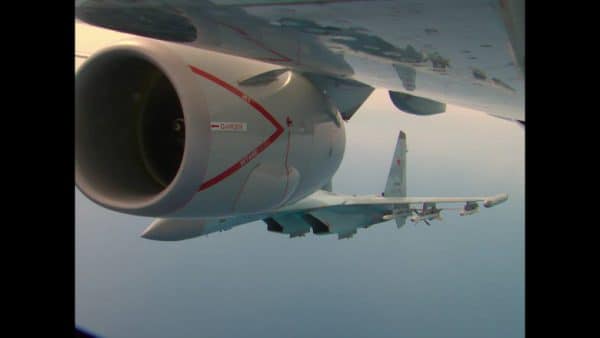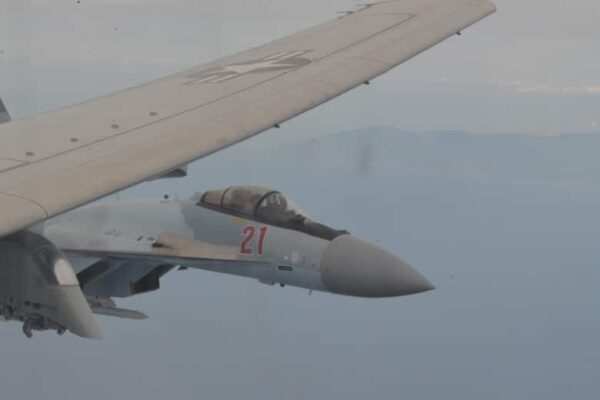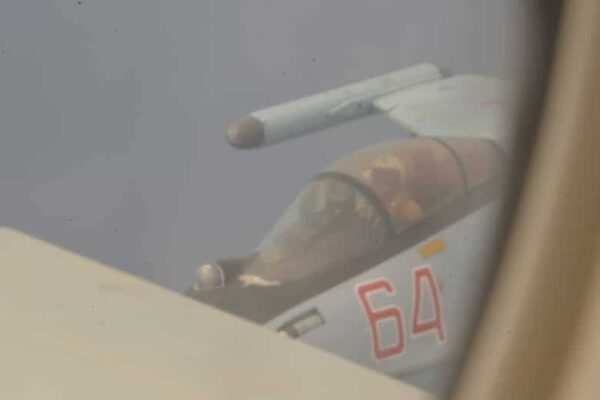A pair of Russian Su-35 fighter jets dangerously intercepted a U.S. Navy P-8A Poseidon maritime patrol and reconnaissance plane over the eastern Mediterranean on Tuesday in the U.S. 6th Fleet’s area of operations.
The two Russian jets stayed close to each wing of the P-8A in what the U.S. Navy’s 6th Fleet press release described as “unsafe and unprofessional” behavior that restricted the P-8A’s ability to safely maneuver. The intercept lasted around 65 minutes.
“The unnecessary actions of the Russian Su-35 pilots were inconsistent with good airmanship and international flight rules, and jeopardized the safety of flight of both aircraft,” the 6th Fleet said in their statement. “While the Russian aircraft was operating in international airspace, this interaction was irresponsible. We expect them to operate within international standards set to ensure safety and to prevent incidents.”
It was not immediately clear how close the Russian fighter jets were flying in this latest incident, though the Russian pilots could clearly be seen in photos released by the Navy.
The 6th Fleet listed the 1972 Agreement for the Prevention of Incidents On and Over the High Seas (INCSEA) as one particular accord intended to prevent incidents like the one on Tuesday.

Two Russian Su-35 aircraft unsafely intercept a P-8A Poseidon patrol aircraft assigned to U.S. 6th Fleet over the Mediterranean Sea May 26, 2020. (U.S. Navy photo, U.S. 6th Fleet, released)
Close intercepts like the one seen Tuesday increase the risk for mid-air collisions.

Two Russian Su-35 aircraft unsafely intercept a P-8A Poseidon patrol aircraft assigned to U.S. 6th Fleet over the Mediterranean Sea May 26, 2020. (U.S. Navy photo, U.S. 6th Fleet, released)
Further photos appeared to show the jets flying directly under the P-8A’s wings.

Two Russian Su-35 aircraft unsafely intercept a P-8A Poseidon patrol aircraft assigned to U.S. 6th Fleet over the Mediterranean Sea May 26, 2020. (U.S. Navy photo, U.S. 6th Fleet, released)
The latest close Russian intercept follows two similar incidents over the Mediterranean Sea in April. In the previous incidents, Russian Su-35 jets flew within 25 feet of U.S. P-8A’s, coming so close that they caused wake turbulence for the U.S. aircraft.
The first April 15 incident even saw the Su-35 jet in question flying an inverted pass within feet of the P-8A.

Two Russian Su-35 aircraft unsafely intercept a P-8A Poseidon patrol aircraft assigned to U.S. 6th Fleet over the Mediterranean Sea May 26, 2020. (U.S. Navy photo, U.S. 6th Fleet, released)
The second close intercept incident occurred four days later on April 19, when a Russian Su-35 jet once again flew within 25 feet of a P-8A patrolling over the Mediterranean.

Two Russian Su-35 aircraft unsafely intercept a P-8A Poseidon patrol aircraft assigned to U.S. 6th Fleet over the Mediterranean Sea May 26, 2020. (U.S. Navy photo, U.S. 6th Fleet, released)
“In all cases, the U.S. aircraft were operating in international airspace, consistent with international law, with due regard for safety of flight, and did not provoke this Russian activity,” the 6th Fleet said of the three incidents.

Two Russian Su-35 aircraft unsafely intercept a P-8A Poseidon patrol aircraft assigned to U.S. 6th Fleet over the Mediterranean Sea May 26, 2020. (U.S. Navy photo, U.S. 6th Fleet, released)
The latest intercept incident came just days after the U.S. Africa Command (AFRICOM) released photos showing Russian fighter jets flying from Syria to Libya, which AFRICOM assessed were being deployed to support Russian mercenary groups fighting on behalf of Khalifa Hafter and his Libyan National Army (LNA) in efforts to defeat the Libyan Government of National Accord (GNA).
Four Russian jets were also observed circling the airspace above the missile destroyer USS Donald Cook in another April incident in the Baltic Sea. A Belgian Air Force F-16 on assignment with NATO later attempted to intercept and disperse the Russian aircraft, including a pair of Su-24 fighters, a Su-27 and Su-30SM.



